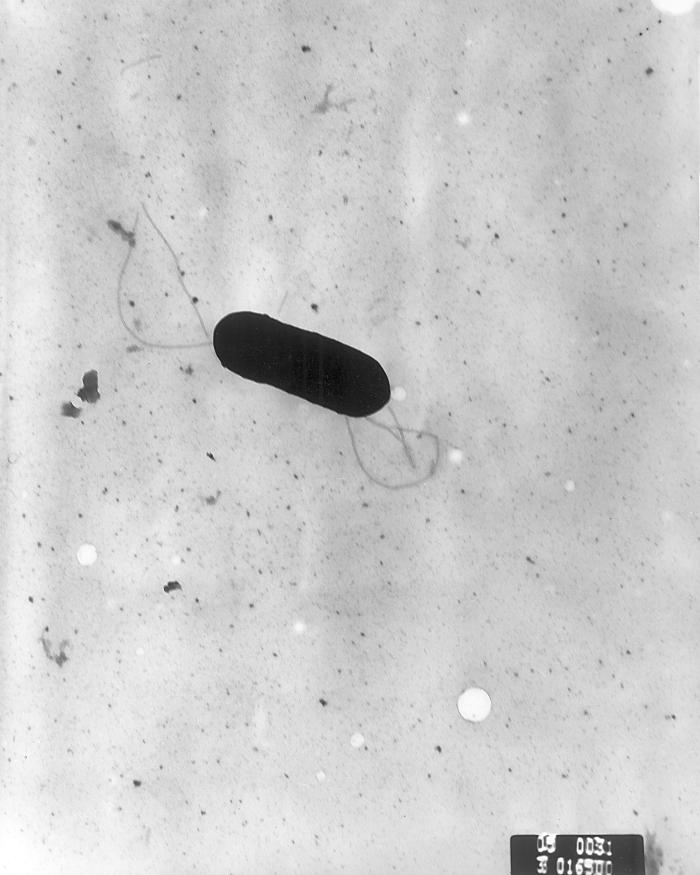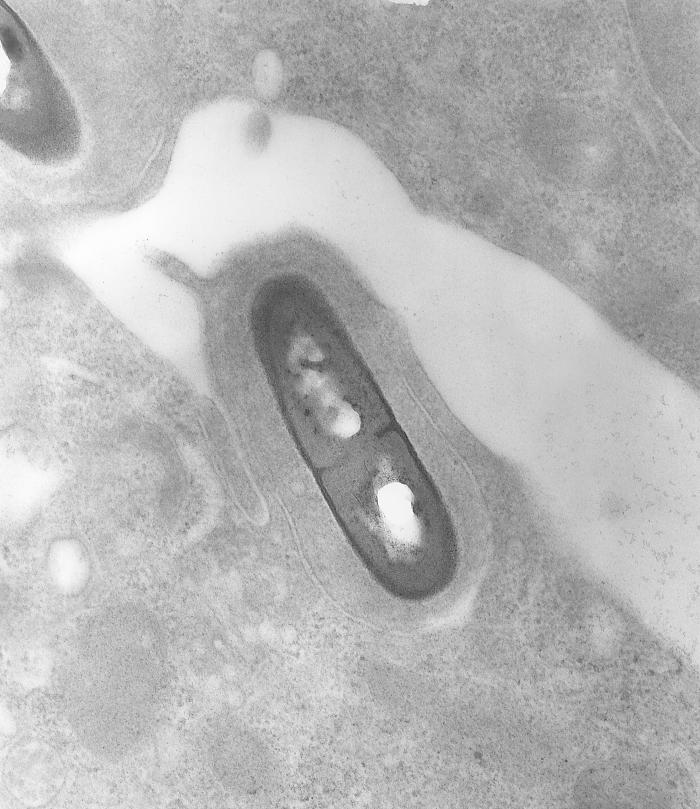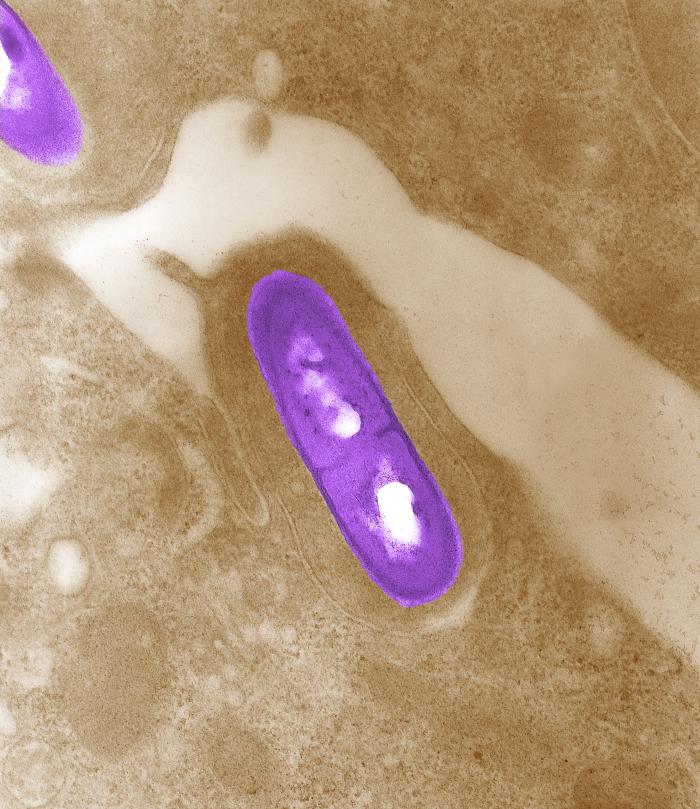Listeria monocytogenes: Difference between revisions
Joao Silva (talk | contribs) |
YazanDaaboul (talk | contribs) (→Cause) |
||
| (46 intermediate revisions by 4 users not shown) | |||
| Line 1: | Line 1: | ||
__NOTOC__ | __NOTOC__ | ||
{{ | {{Listeriosis}} | ||
{{ | {{Taxobox | ||
| color = lightgrey <!-- Please read [[WP:Taxobox usage#Color]] before making any changes to the taxobox color. --> | |||
| name = ''Listeria'' | |||
| image =Listeria monocytogenes PHIL 2287 lores.jpg | |||
| image_width = 240px | |||
| image_caption = [[Scanning electron microscope|Scanning electron micrograph]] of ''Listeria monocytogenes''. | |||
| regnum = [[Bacterium|Bacteria]] | |||
| divisio = [[Firmicutes]] | |||
| classis = [[Bacilli]] | |||
| ordo = [[Bacillales]] | |||
| familia = [[Listeriaceae]] | |||
| genus = ''Listeria'' | |||
| genus_authority = [[Harvey Pirie|Pirie]] 1940 | |||
| subdivision_ranks = Species | |||
| subdivision = | |||
''[[Listeria fleischmannii|L. fleischmannii]]''<br /> | |||
''[[Listeria grayi|L. grayi]]''<br /> | |||
''[[Listeria innocua|L. innocua]]''<br /> | |||
''[[Listeria ivanovii|L. ivanovii]]''<br /> | |||
''[[Listeria marthii|L. marthii]]''<br /> | |||
''[[Listeria monocytogenes|L. monocytogenes]]''<br /> | |||
''[[Listeria rocourtiae|L. rocourtiae]]''<br /> | |||
''[[Listeria seeligeri|L. seeligeri]]''<br /> | |||
''[[Listeria weihenstephanensis|L. weihenstephanensis]]''<br /> | |||
''[[Listeria welshimeri|L. welshimeri]]'' | |||
}} | |||
{{About0|Listeriosis}} | |||
{{CMG}}; {{AE}} {{JS}} | {{CMG}}; {{AE}} {{JS}} | ||
==Overview== | ==Overview== | ||
Listeriosis is caused by the bacterium ''Listeria monocytogenes'', a flagellated, [[catalase-positive]], facultative [[intracellular]], [[anaerobe|anaerobic]], [[spore|nonsporulating]], [[Gram-positive]] [[bacillus]]. ''Listeria'' is commonly found in soil, water, vegetation and fecal material.<ref name=WHO>{{cite web | title = Risk assessment of Listeria monocytogenes in ready-to-eat foods | url = http://whqlibdoc.who.int/publications/2004/9241562625_part1.pdf }}</ref> | |||
== | ==Cause== | ||
*Listeriosis is caused by the bacterium ''Listeria spp''. | |||
*''Listeria monocytogenes'' is the most common species associated with development of listeriosis. | |||
*The genus ''Listeria'' contains ten species: | |||
:*''L. fleischmannii'' | |||
:*''L. grayi'' | |||
:*''L. innocua'' | |||
:*''L. ivanovii'' | |||
:*''L. marthii'' | |||
:*''L. monocytogenes'' | |||
:*''L. rocourtiae'' | |||
:*''L. seeligeri'' | |||
:*''L. weihenstephanensis'' | |||
:*''L. welshimeri'' | |||
*Of note, ''Listeria dinitrificans'' was previously thought to be part of the ''Listeria'' genus, but it has been reclassified into the new genus ''[[Jonesia]]''.<ref name=collins>M. D. Collins, S. Wallbanks, D. J. Lane, J. Shah, R. Nietupskin, J. Smida, M. Dorsch and E. Stackebrandt. Phylogenetic Analysis of the Genus ''Listeria'' Based on Reverse Transcriptase Sequencing of 16S rRNA. International Journal of Systematic and Evolutionary Microbiology. April 1991 vol. 41 no. 2 240–246</ref> | |||
''Listeria | |||
==Taxonomy== | |||
[[Bacteria]]; [[Firmicutes]]; [[Bacilli]]; [[Bacillales]]; [[Listeriaceae]]; [[Listeria]]; [[Listeria monocytogenes]]. | |||
== | ==Microbiological Characteristics== | ||
*''Listeria monocytogenes'' is a flagellated, [[catalase-positive]], facultative [[intracellular]], [[anaerobe|anaerobic]], [[spore|nonsporulating]], [[Gram-positive]] [[bacillus]]. | |||
==Natural Reservoir== | ==Natural Reservoir== | ||
* ''L. monocytogenes'' has been associated with such | *In the environment, ''Listeria monocytogenes'' is commonly found in soil, water, vegetation and fecal material. | ||
* | *Animals may be asymptomatic carriers of ''Listeria''.<ref name=WHO>{{cite web | title = Risk assessment of Listeria monocytogenes in ready-to-eat foods | url = http://whqlibdoc.who.int/publications/2004/9241562625_part1.pdf }}</ref> | ||
*''L. monocytogenes'' has been associated with foods such as raw [[milk]], pasteurized fluid milk, [[cheese]]s (particularly soft-ripened varieties), [[ice cream]], raw [[vegetables]], fermented raw-meat sausages, raw and cooked [[poultry]], raw meats, and raw and smoked [[fish]].<ref name=Fleming_1985>Fleming, D. W., S. L. Cochi, K. L. MacDonald, J. Brondum, P. S. Hayes, B. D. Plikaytis, M. B. Holmes, A. Audurier, C. V. Broome, and A. L. Reingold. 1985. Pasteurized milk as a vehicle of infection in an outbreak of listeriosis. N. Engl. J. Med. 312:404-407.</ref> | |||
*''Listeria'' has the ability to grow at temperatures as low as 0°C, allows its multiplication in refrigerated foods. At refrigerated temperature such as 4°C, the amount of ferric iron in the environment promotes the growth of ''L. monocytogenes''.<ref name=Dworaczek_Kubo_Dykes_2002>Dykes, G. A., Dworaczek (Kubo), M. 2002. Influence of interactions between temperature, ferric ammonium citrate and glycine betaine on the growth of ''Listeria monocytogenes'' in a defined medium. Lett Appl Microbiol. 35(6):538-42.</ref> | |||
[[Image: | ==Gallery== | ||
[[Image:Listeria2.jpg|thumb|none| Electron micrograph of a Listeria bacterium in tissue.<SMALL><SMALL>''[http://phil.cdc.gov/phil/ Adapted from Public Health Image Library (PHIL), Centers for Disease Control and Prevention.]''<ref name="PHIL">{{Cite web | title = Public Health Image Library (PHIL), Centers for Disease Control and Prevention | url = http://phil.cdc.gov/phil/}}</ref></SMALL></SMALL>]] | |||
[[Image:Listeria3.jpg|thumb|none| Electron micrograph of a Listeria bacterium in tissue.<SMALL><SMALL>''[http://phil.cdc.gov/phil/ Adapted from Public Health Image Library (PHIL), Centers for Disease Control and Prevention.]''<ref name="PHIL">{{Cite web | title = Public Health Image Library (PHIL), Centers for Disease Control and Prevention | url = http://phil.cdc.gov/phil/}}</ref></SMALL></SMALL>]] | |||
==References== | ==References== | ||
{{Reflist|2}} | {{Reflist|2}} | ||
Latest revision as of 17:11, 25 January 2016
|
Listeriosis Microchapters |
|
Diagnosis |
|---|
|
Treatment |
|
Case Studies |
|
Listeria monocytogenes On the Web |
|
American Roentgen Ray Society Images of Listeria monocytogenes |
|
Risk calculators and risk factors for Listeria monocytogenes |
| Listeria | ||||||||||||
|---|---|---|---|---|---|---|---|---|---|---|---|---|
 Scanning electron micrograph of Listeria monocytogenes.
| ||||||||||||
| Scientific classification | ||||||||||||
| ||||||||||||
| Species | ||||||||||||
|
L. fleischmannii |
Editor-In-Chief: C. Michael Gibson, M.S., M.D. [1]; Associate Editor(s)-in-Chief: João André Alves Silva, M.D. [2]
Overview
Listeriosis is caused by the bacterium Listeria monocytogenes, a flagellated, catalase-positive, facultative intracellular, anaerobic, nonsporulating, Gram-positive bacillus. Listeria is commonly found in soil, water, vegetation and fecal material.[1]
Cause
- Listeriosis is caused by the bacterium Listeria spp.
- Listeria monocytogenes is the most common species associated with development of listeriosis.
- The genus Listeria contains ten species:
- L. fleischmannii
- L. grayi
- L. innocua
- L. ivanovii
- L. marthii
- L. monocytogenes
- L. rocourtiae
- L. seeligeri
- L. weihenstephanensis
- L. welshimeri
- Of note, Listeria dinitrificans was previously thought to be part of the Listeria genus, but it has been reclassified into the new genus Jonesia.[2]
Taxonomy
Bacteria; Firmicutes; Bacilli; Bacillales; Listeriaceae; Listeria; Listeria monocytogenes.
Microbiological Characteristics
- Listeria monocytogenes is a flagellated, catalase-positive, facultative intracellular, anaerobic, nonsporulating, Gram-positive bacillus.
Natural Reservoir
- In the environment, Listeria monocytogenes is commonly found in soil, water, vegetation and fecal material.
- Animals may be asymptomatic carriers of Listeria.[1]
- L. monocytogenes has been associated with foods such as raw milk, pasteurized fluid milk, cheeses (particularly soft-ripened varieties), ice cream, raw vegetables, fermented raw-meat sausages, raw and cooked poultry, raw meats, and raw and smoked fish.[3]
- Listeria has the ability to grow at temperatures as low as 0°C, allows its multiplication in refrigerated foods. At refrigerated temperature such as 4°C, the amount of ferric iron in the environment promotes the growth of L. monocytogenes.[4]
Gallery


References
- ↑ 1.0 1.1 "Risk assessment of Listeria monocytogenes in ready-to-eat foods" (PDF).
- ↑ M. D. Collins, S. Wallbanks, D. J. Lane, J. Shah, R. Nietupskin, J. Smida, M. Dorsch and E. Stackebrandt. Phylogenetic Analysis of the Genus Listeria Based on Reverse Transcriptase Sequencing of 16S rRNA. International Journal of Systematic and Evolutionary Microbiology. April 1991 vol. 41 no. 2 240–246
- ↑ Fleming, D. W., S. L. Cochi, K. L. MacDonald, J. Brondum, P. S. Hayes, B. D. Plikaytis, M. B. Holmes, A. Audurier, C. V. Broome, and A. L. Reingold. 1985. Pasteurized milk as a vehicle of infection in an outbreak of listeriosis. N. Engl. J. Med. 312:404-407.
- ↑ Dykes, G. A., Dworaczek (Kubo), M. 2002. Influence of interactions between temperature, ferric ammonium citrate and glycine betaine on the growth of Listeria monocytogenes in a defined medium. Lett Appl Microbiol. 35(6):538-42.
- ↑ 5.0 5.1 "Public Health Image Library (PHIL), Centers for Disease Control and Prevention".